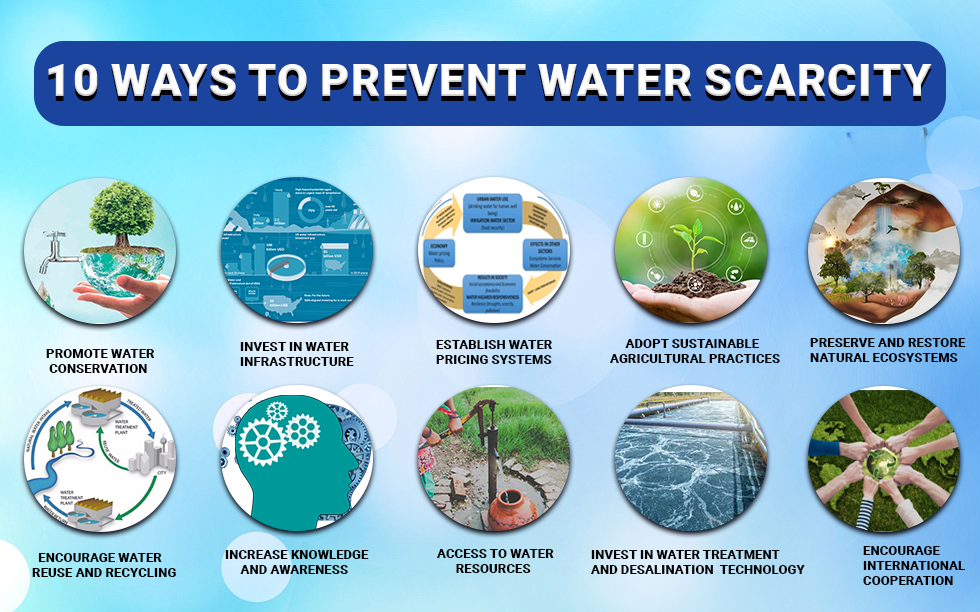Ways to Save Water

At Home:
- Fix leaks.
- Use buckets instead of hoses.
- Reuse water (e.g., for plants).
- Turn off taps when not needed.
- Collect rainwater for chores.
At School:
- Fix leaking taps.
- Use water-efficient toilets.
- Promote water-saving awareness.
- Encourage reusable water bottles.
In Villages, Towns & Cities:
- Install rainwater harvesting systems.
- Use drip irrigation in farming.
- Recycle wastewater.
- Run public awareness campaigns.
- Regulate groundwater use.
General Facts on Water Conservation:
- Global Water Scarcity:
- According to the United Nations, around 2.3 billion people live in water-stressed countries, and by 2025, nearly two-thirds of the world’s population may face water shortages.
- Household Water Usage:
- A leaking tap can waste up to 11,000 liters of water per year. (U.S. Environmental Protection Agency – EPA)
- Turning off the tap while brushing your teeth can save up to 7-8 liters of water per minute (World Health Organization – WHO).
- Agriculture and Water Usage:
- Agriculture accounts for about 70% of global freshwater withdrawals, making it the largest water-consuming sector (Food and Agriculture Organization – FAO).
- Drip irrigation can save up to 30-70% more water compared to traditional flood irrigation methods.
- Rainwater Harvesting:
- A 1,000 sq. ft. roof can collect around 24,000 liters of rainwater annually, depending on rainfall levels (Centre for Science and Environment – CSE, India).
- Urban Water Recycling:
- Countries like Singapore recycle up to 40% of their wastewater for non-drinking purposes, reducing dependency on natural water sources (PUB Singapore).
Water Conservation Efforts in Schools, Homes, and Cities:
- Water-Efficient Appliances:
- Using low-flow toilets and aerated faucets can reduce water usage by 20-50%. (EPA, USA)
- Community Awareness:
- Countries like Israel have implemented nationwide campaigns, reducing domestic water usage by 30% over the past two decades.
- Desalination for Water Supply:
- The world’s largest desalination plant in Saudi Arabia provides drinking water to millions of people, showing how technology can help in water conservation.
Local Water-Saving Practices:
- In India, traditional methods like “Stepwells” (Baolis) and “Johads” (small earthen dams) are used in Rajasthan to conserve rainwater.
- Tamil Nadu made rainwater harvesting mandatory in 2003, significantly improving groundwater levels in the state.
FAQs
Water conservation is essential because freshwater is limited. Only 2.5% of Earth’s water is freshwater, and much of it is locked in glaciers or underground. Saving water ensures there is enough for future generations, helps prevent droughts, and protects the environment.
You can save water at home by:
► Fixing leaks
► Turning off taps while brushing teeth
► Using water-efficient appliances
► Collecting rainwater for gardening
► Using a bucket instead of a hose for washing vehicles
Rainwater harvesting helps in:
► Recharging groundwater levels
► Reducing dependency on municipal water supply
► Providing water for household and irrigation purposes
► Preventing urban flooding
A dripping tap can waste 11,000 liters of water per year. Fixing leaks can prevent unnecessary wastage and reduce water bills.
Farmers can save water by:
► Using drip irrigation (saves up to 70% of water compared to flood irrigation)
► Practicing mulching to reduce evaporation
► Growing drought-resistant crops
► Using rainwater harvesting for irrigation







